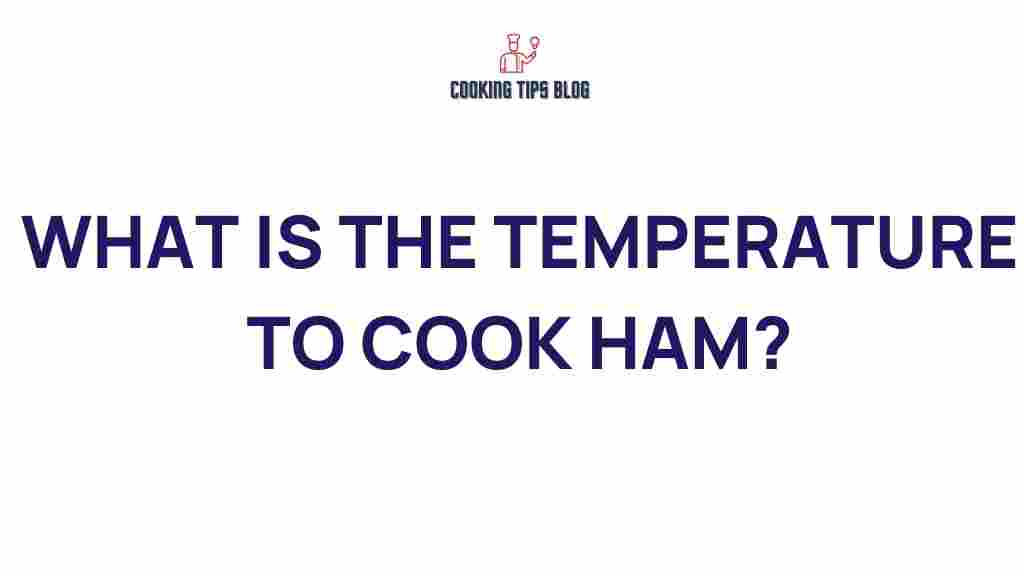Mastering the Perfect Temperature to Cook Ham: Understanding Cooking Temperature
Cooking ham is a culinary tradition that brings warmth and joy to tables around the world, especially during holidays and special occasions. However, to ensure the best flavor and safety, it is essential to master the perfect cooking temperature. In this guide, we will explore the ideal temperatures for cooking different types of ham, discuss the importance of food safety, and provide tips to troubleshoot common issues that arise during the cooking process.
Understanding the Basics of Ham
Before diving into the specifics of cooking temperature, let’s first understand what ham is. Ham is the cured leg of pork, and it comes in various forms:
- Fresh Ham: Uncooked and not cured.
- Cured Ham: Treated with salt and other preservatives.
- Smoked Ham: Cured and then smoked for flavor.
- Spiral-Sliced Ham: Pre-sliced for easy serving.
The Importance of Cooking Temperature
Cooking temperature is crucial for several reasons:
- Flavor: The right temperature enhances the natural flavors of the ham.
- Texture: Proper cooking ensures a tender and juicy result.
- Food Safety: Cooking ham to the right temperature kills harmful bacteria.
Ideal Cooking Temperatures for Different Types of Ham
Different types of ham require different cooking temperatures to achieve the best results. Here’s a breakdown of recommended cooking temperatures:
1. Fresh Ham
For fresh ham, the USDA recommends cooking it to an internal temperature of 145°F (63°C). Ensure you allow it to rest for at least three minutes before slicing to retain juices.
2. Cured Ham
Cured ham is typically already cooked, so it needs only to be reheated. Aim for an internal temperature of 140°F (60°C).
3. Smoked Ham
If you have a smoked ham, heat it to an internal temperature of 140°F (60°C) for optimal flavor and texture.
4. Spiral-Sliced Ham
Spiral-sliced ham is often pre-cooked and only needs to be warmed. Heat it to 140°F (60°C) as well.
Step-by-Step Process for Cooking Ham
Now that you understand the ideal cooking temperatures, let’s go through a step-by-step process for cooking ham:
Step 1: Prepare Your Ham
Remove the ham from the refrigerator and let it sit at room temperature for about 30 minutes. This helps it cook more evenly.
Step 2: Preheat Your Oven
Preheat your oven to 325°F (163°C). This temperature is ideal for cooking ham slowly and evenly.
Step 3: Season Your Ham
If you’re using a fresh or uncooked ham, season it with your choice of herbs, spices, and marinades. For cured or smoked ham, a glaze can enhance flavor.
Step 4: Place the Ham in the Oven
Put the ham in a roasting pan, cut-side down if it’s spiral-sliced, and cover it with foil to retain moisture.
Step 5: Monitor the Temperature
Use a meat thermometer to check the internal temperature. Insert the thermometer into the thickest part of the ham, avoiding the bone. Keep cooking until you reach the desired temperature:
- Fresh Ham: 145°F (63°C)
- Cured/Smoked Ham: 140°F (60°C)
- Spiral-Sliced Ham: 140°F (60°C)
Step 6: Let It Rest
Once the ham has reached the desired temperature, remove it from the oven and let it rest for about 15-20 minutes. This step allows the juices to redistribute, making for a juicier ham.
Common Troubleshooting Tips
Even with the best intentions, things can go wrong in the kitchen. Here are some common issues and how to troubleshoot them:
Issue 1: Ham is Too Dry
If your ham turns out dry, it may have been overcooked. To avoid this, use a meat thermometer to ensure you reach the perfect cooking temperature and avoid cooking for too long.
Issue 2: Undercooked Ham
Undercooked ham can pose health risks. Always check the internal temperature using a meat thermometer. If it’s undercooked, return it to the oven until it reaches the recommended temperature.
Issue 3: Lack of Flavor
If your ham lacks flavor, consider marinating it beforehand or applying a glaze while it cooks. A mix of brown sugar, honey, and mustard can create a delicious crust.
Issue 4: Uneven Cooking
To ensure even cooking, choose a ham that is uniform in shape. Also, rotating the ham during cooking can help achieve consistent results.
Conclusion
Mastering the perfect cooking temperature for ham is essential for both flavor and food safety. By understanding the different types of ham and their respective cooking temperatures, you can ensure a delicious and satisfying meal. Remember to monitor the internal temperature closely, allow your ham to rest before serving, and don’t hesitate to experiment with seasonings and glazes. For more tips on cooking various meats, check out our meat cooking guide.
For additional food safety guidelines, visit the USDA’s official page on cooking meats safely.
This article is in the category Recipes and created by Cookingtipsblog Team
